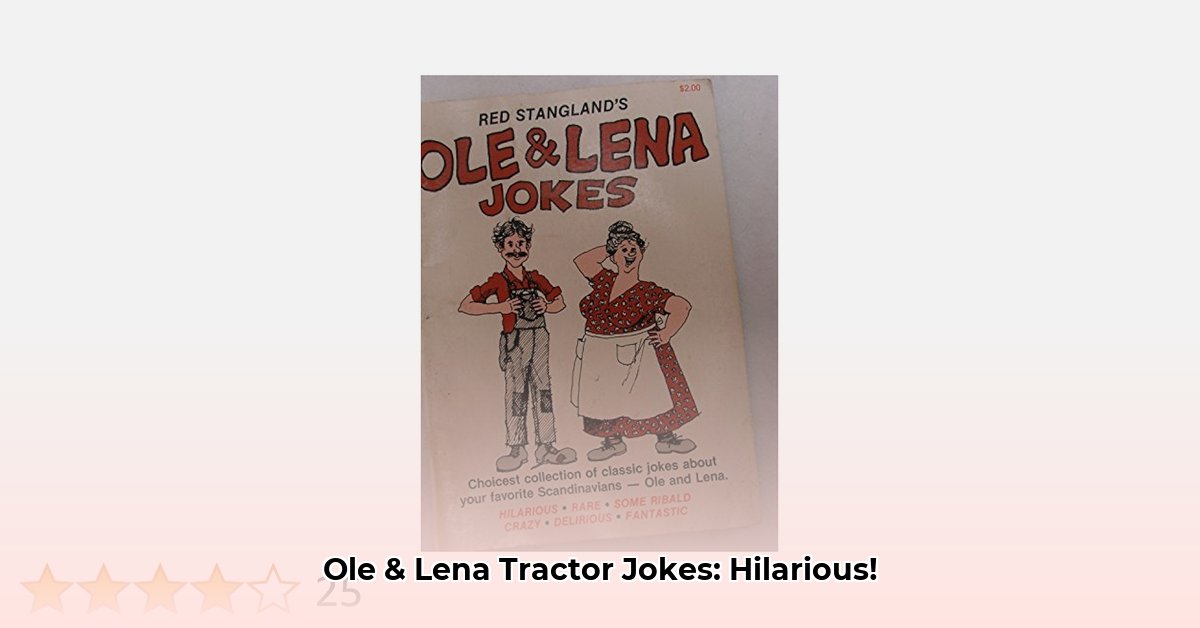
Let's face it: sometimes the simplest jokes are the best. And few comedic duos deliver simple, perfectly-timed laughs quite like Ole and Lena. Their tractor-based misadventures have become a timeless source of amusement, a testament to the enduring power of a well-crafted pun and a perfectly-timed misunderstanding. Before we dissect the formula, here's a quick one to get the comedic engine revving: Ole says to Lena, "I think I've found a way to make our tractor go faster." Lena replies, "How, by removing the brakes?"
Decoding the Ole and Lena Formula: Why They Work (Mostly)
So, what's the secret sauce? It's a deceptively simple recipe: take a slightly dim-witted Ole, add a sharp-witted Lena, and season with a generous pinch of Scandinavian charm. The humor arises from the clash of their personalities – like oil and water, they don't mix, resulting in a series of hilarious misunderstandings. Most jokes follow a classic question-and-answer format or the familiar setup-punchline structure. Simple, effective, and usually enough to elicit a chuckle (and maybe a groan). But are these jokes always comedic gold? Let's be honest, sometimes they fall flat. Let's explore why.
A Roundup of the Best Ole and Lena Tractor Jokes
Here’s a curated selection showcasing the comedic genius of Ole and Lena, featuring jokes that consistently deliver the laughs:
The Tire Trouble: Ole: "Lena, I think we have a flat tire." Lena: “Well, then drive on the other side of the road!”
The Plow Predicament: Ole: "Lena, the plow's broken!" Lena: "Did you try turning it around?" Ole: "Yep, and I broke the other side..."
The New Tractor Purchase: Ole: "Lena, I bought a new tractor!" Lena: "Did you at least check the price first?"
Lefse and Mud: Ole: "Lena, the tractor's stuck in the mud again." Lena: "Well, at least we have plenty of lefse." (Lefse, a delicious Scandinavian flatbread, adds a cultural layer to the humor.)
The Mysterious Engine Noise: Ole: "Lena, there's a funny noise coming from the tractor." Lena: "That's probably just the sound of your money disappearing."
The Good, the Bad, and the Lefse: An Honest Assessment
These jokes work because of their simplicity, relatability, and ease of understanding. The familiar dynamic between Ole and Lena instantly sets the stage, creating an immediate comedic connection. They're easily shareable and rarely require extensive explanation. But, like all good things, there’s a downside. The humor sometimes relies heavily on stereotypes, which can be problematic. Aren't we laughing with Ole and Lena, rather than at them? This is a crucial point to consider. Moreover, the jokes can become repetitive if not handled with creativity—variety is the spice of life, even in the world of tractor jokes.
The Future of Ole and Lena: Will They Keep Us Laughing?
What's the future for these comedic icons? Their simplicity and quick punchlines are undeniably winning. But to stay relevant, they may need a refresh. Perhaps a modern twist on the characters, incorporating contemporary issues, could breathe new life into the formula. The key is to retain the core charm while evolving to reflect modern sensibilities.
How to Write Your Own Ole and Lena Tractor Jokes
Key Takeaways:
- Classic Ole and Lena jokes use simple setups and punchlines, often incorporating puns and wordplay.
- The humor derives from cultural references (Scandinavian heritage) and relatable farming situations.
- Understanding the contrasting personalities (Ole’s naiveté, Lena’s resourcefulness) is crucial for crafting believable jokes.
- Successfully writing new Ole and Lena jokes involves creatively leveraging misunderstandings and situational irony.
- Remember to avoid offensive stereotypes; keep the humor light and relatable.
Deconstructing the Formula: What Makes Them Tick?
These jokes are like well-oiled machines—simple, predictable, and consistently funny. They follow a classic setup-punchline structure. Ole usually asks a question or makes a statement, setting the scene. Lena, with her quick wit, delivers the unexpected punchline, often based on a pun or wordplay. It’s a comedic dance – a well-rehearsed routine that always delivers.
The secret ingredient? The contrast between Ole and Lena. Their opposing personalities create a dynamic that's been working for decades, proving that sometimes the simplest formula is the most effective.
Crafting Your Own Hilarious Tractor Tales: A Step-by-Step Guide
Here's how to unleash your inner humorist:
- Brainstorm: Consider classic Ole and Lena scenarios: tractors malfunctioning, farm animals behaving badly, or miscommunication.
- Develop the Setup: Create a simple, clear setup. Ole asks a question or makes a statement.
- Create the Punchline: The punchline must be unexpected yet cleverly tied to the setup. Use puns, wordplay, or ironic situations.
- Refine and Polish: Read it aloud. Does it flow? Does it land with the desired comedic impact? Revise.
- Test Your Joke: Share it! Feedback is crucial.
Strengths and Weaknesses: A Critical Assessment
Strengths: Simplicity, puns, relatability, consistent characters.
Weaknesses: Stereotypes (use mindfully!), repetition (avoid predictability), limited appeal (familiarity with characters helps).
Expanding the Horizons: Beyond the Tractor
While tractors are a staple, consider new avenues. Could Ole and Lena grapple with modern technology? The possibilities are endless! The key is to maintain their core dynamic while injecting fresh narratives.